Reality Technologies in Clinical Training and Impact on Patient Safety
VerifiedAdded on 2023/06/04
|10
|2971
|382
Literature Review
AI Summary
This literature review examines the role of virtual reality technologies (VRT) in clinical training and its impacts on patient safety and the quality of care. The review highlights that VRT, especially simulation-based medical education (SBME), significantly improves patient safety by enhancing the technical and human-factor skills of medical professionals. Studies show that VRT improves trainee confidence, knowledge, and skills, particularly in surgical and pediatric settings. Acceptance of VRT is high due to its 3D graphics and realistic simulations, which aid in understanding complex anatomy. While VRT offers advantages like training in critical scenarios and improved surgical outcomes, it faces limitations such as financial constraints and issues with haptic feedback. The review suggests that re-evaluating haptic feedback and ensuring cost-effectiveness are crucial for the broader adoption of VRT in clinical training. Overall, the literature supports the use of VRT as an effective tool for improving clinical skills and patient outcomes, provided its limitations are addressed.
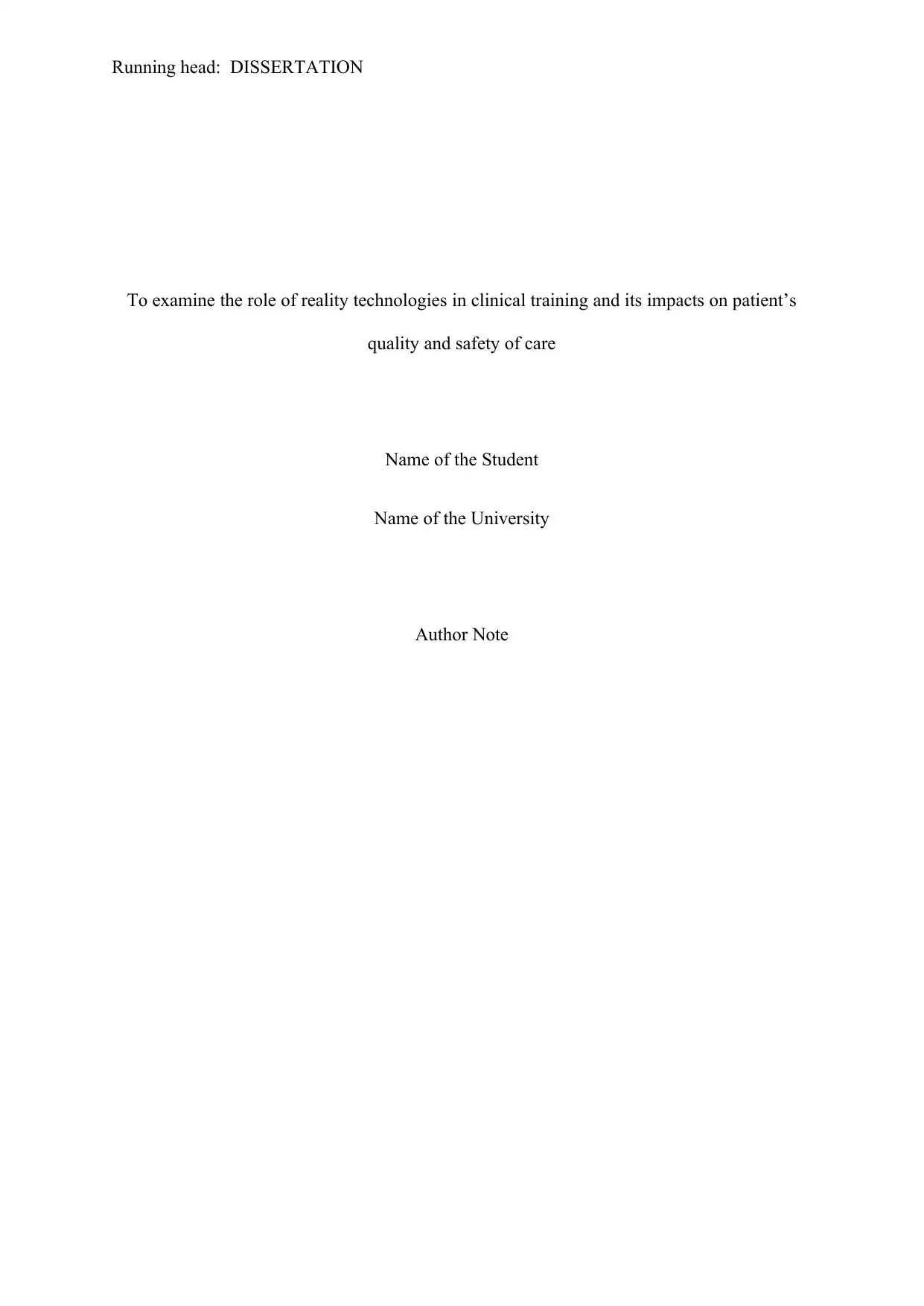
Running head: DISSERTATION
To examine the role of reality technologies in clinical training and its impacts on patient’s
quality and safety of care
Name of the Student
Name of the University
Author Note
To examine the role of reality technologies in clinical training and its impacts on patient’s
quality and safety of care
Name of the Student
Name of the University
Author Note
Paraphrase This Document
Need a fresh take? Get an instant paraphrase of this document with our AI Paraphraser
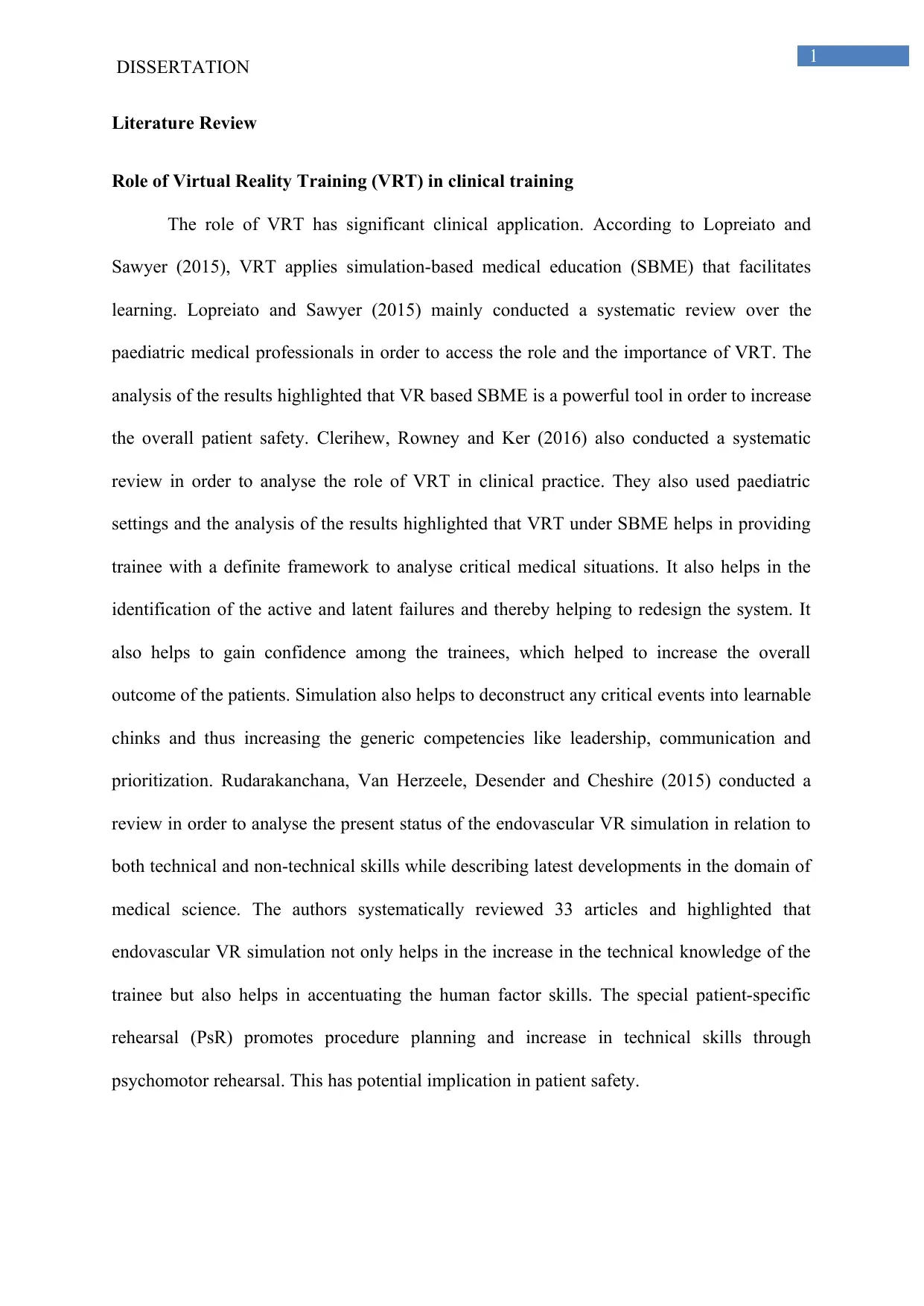
1
DISSERTATION
Literature Review
Role of Virtual Reality Training (VRT) in clinical training
The role of VRT has significant clinical application. According to Lopreiato and
Sawyer (2015), VRT applies simulation-based medical education (SBME) that facilitates
learning. Lopreiato and Sawyer (2015) mainly conducted a systematic review over the
paediatric medical professionals in order to access the role and the importance of VRT. The
analysis of the results highlighted that VR based SBME is a powerful tool in order to increase
the overall patient safety. Clerihew, Rowney and Ker (2016) also conducted a systematic
review in order to analyse the role of VRT in clinical practice. They also used paediatric
settings and the analysis of the results highlighted that VRT under SBME helps in providing
trainee with a definite framework to analyse critical medical situations. It also helps in the
identification of the active and latent failures and thereby helping to redesign the system. It
also helps to gain confidence among the trainees, which helped to increase the overall
outcome of the patients. Simulation also helps to deconstruct any critical events into learnable
chinks and thus increasing the generic competencies like leadership, communication and
prioritization. Rudarakanchana, Van Herzeele, Desender and Cheshire (2015) conducted a
review in order to analyse the present status of the endovascular VR simulation in relation to
both technical and non-technical skills while describing latest developments in the domain of
medical science. The authors systematically reviewed 33 articles and highlighted that
endovascular VR simulation not only helps in the increase in the technical knowledge of the
trainee but also helps in accentuating the human factor skills. The special patient-specific
rehearsal (PsR) promotes procedure planning and increase in technical skills through
psychomotor rehearsal. This has potential implication in patient safety.
DISSERTATION
Literature Review
Role of Virtual Reality Training (VRT) in clinical training
The role of VRT has significant clinical application. According to Lopreiato and
Sawyer (2015), VRT applies simulation-based medical education (SBME) that facilitates
learning. Lopreiato and Sawyer (2015) mainly conducted a systematic review over the
paediatric medical professionals in order to access the role and the importance of VRT. The
analysis of the results highlighted that VR based SBME is a powerful tool in order to increase
the overall patient safety. Clerihew, Rowney and Ker (2016) also conducted a systematic
review in order to analyse the role of VRT in clinical practice. They also used paediatric
settings and the analysis of the results highlighted that VRT under SBME helps in providing
trainee with a definite framework to analyse critical medical situations. It also helps in the
identification of the active and latent failures and thereby helping to redesign the system. It
also helps to gain confidence among the trainees, which helped to increase the overall
outcome of the patients. Simulation also helps to deconstruct any critical events into learnable
chinks and thus increasing the generic competencies like leadership, communication and
prioritization. Rudarakanchana, Van Herzeele, Desender and Cheshire (2015) conducted a
review in order to analyse the present status of the endovascular VR simulation in relation to
both technical and non-technical skills while describing latest developments in the domain of
medical science. The authors systematically reviewed 33 articles and highlighted that
endovascular VR simulation not only helps in the increase in the technical knowledge of the
trainee but also helps in accentuating the human factor skills. The special patient-specific
rehearsal (PsR) promotes procedure planning and increase in technical skills through
psychomotor rehearsal. This has potential implication in patient safety.
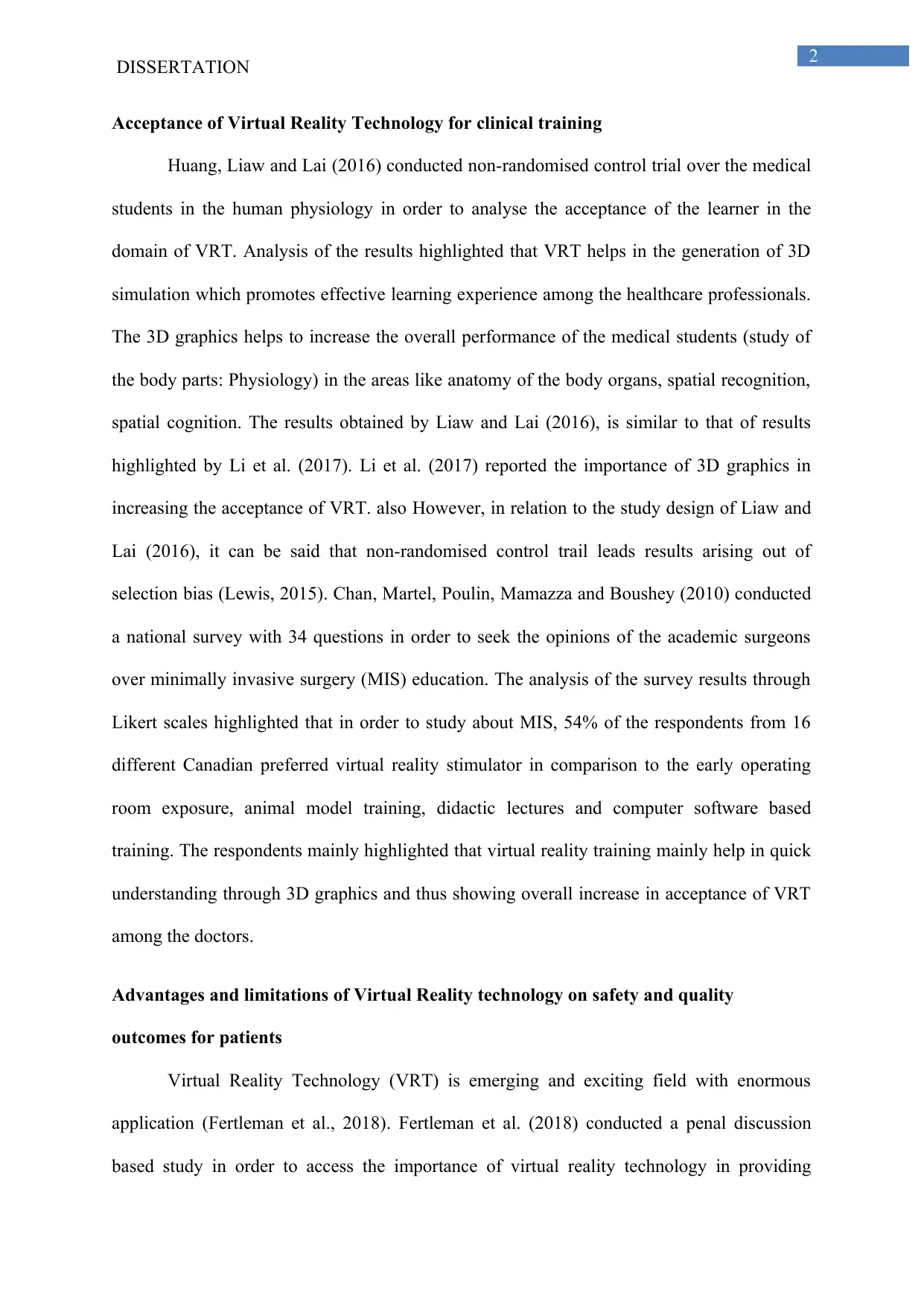
2
DISSERTATION
Acceptance of Virtual Reality Technology for clinical training
Huang, Liaw and Lai (2016) conducted non-randomised control trial over the medical
students in the human physiology in order to analyse the acceptance of the learner in the
domain of VRT. Analysis of the results highlighted that VRT helps in the generation of 3D
simulation which promotes effective learning experience among the healthcare professionals.
The 3D graphics helps to increase the overall performance of the medical students (study of
the body parts: Physiology) in the areas like anatomy of the body organs, spatial recognition,
spatial cognition. The results obtained by Liaw and Lai (2016), is similar to that of results
highlighted by Li et al. (2017). Li et al. (2017) reported the importance of 3D graphics in
increasing the acceptance of VRT. also However, in relation to the study design of Liaw and
Lai (2016), it can be said that non-randomised control trail leads results arising out of
selection bias (Lewis, 2015). Chan, Martel, Poulin, Mamazza and Boushey (2010) conducted
a national survey with 34 questions in order to seek the opinions of the academic surgeons
over minimally invasive surgery (MIS) education. The analysis of the survey results through
Likert scales highlighted that in order to study about MIS, 54% of the respondents from 16
different Canadian preferred virtual reality stimulator in comparison to the early operating
room exposure, animal model training, didactic lectures and computer software based
training. The respondents mainly highlighted that virtual reality training mainly help in quick
understanding through 3D graphics and thus showing overall increase in acceptance of VRT
among the doctors.
Advantages and limitations of Virtual Reality technology on safety and quality
outcomes for patients
Virtual Reality Technology (VRT) is emerging and exciting field with enormous
application (Fertleman et al., 2018). Fertleman et al. (2018) conducted a penal discussion
based study in order to access the importance of virtual reality technology in providing
DISSERTATION
Acceptance of Virtual Reality Technology for clinical training
Huang, Liaw and Lai (2016) conducted non-randomised control trial over the medical
students in the human physiology in order to analyse the acceptance of the learner in the
domain of VRT. Analysis of the results highlighted that VRT helps in the generation of 3D
simulation which promotes effective learning experience among the healthcare professionals.
The 3D graphics helps to increase the overall performance of the medical students (study of
the body parts: Physiology) in the areas like anatomy of the body organs, spatial recognition,
spatial cognition. The results obtained by Liaw and Lai (2016), is similar to that of results
highlighted by Li et al. (2017). Li et al. (2017) reported the importance of 3D graphics in
increasing the acceptance of VRT. also However, in relation to the study design of Liaw and
Lai (2016), it can be said that non-randomised control trail leads results arising out of
selection bias (Lewis, 2015). Chan, Martel, Poulin, Mamazza and Boushey (2010) conducted
a national survey with 34 questions in order to seek the opinions of the academic surgeons
over minimally invasive surgery (MIS) education. The analysis of the survey results through
Likert scales highlighted that in order to study about MIS, 54% of the respondents from 16
different Canadian preferred virtual reality stimulator in comparison to the early operating
room exposure, animal model training, didactic lectures and computer software based
training. The respondents mainly highlighted that virtual reality training mainly help in quick
understanding through 3D graphics and thus showing overall increase in acceptance of VRT
among the doctors.
Advantages and limitations of Virtual Reality technology on safety and quality
outcomes for patients
Virtual Reality Technology (VRT) is emerging and exciting field with enormous
application (Fertleman et al., 2018). Fertleman et al. (2018) conducted a penal discussion
based study in order to access the importance of virtual reality technology in providing
⊘ This is a preview!⊘
Do you want full access?
Subscribe today to unlock all pages.

Trusted by 1+ million students worldwide
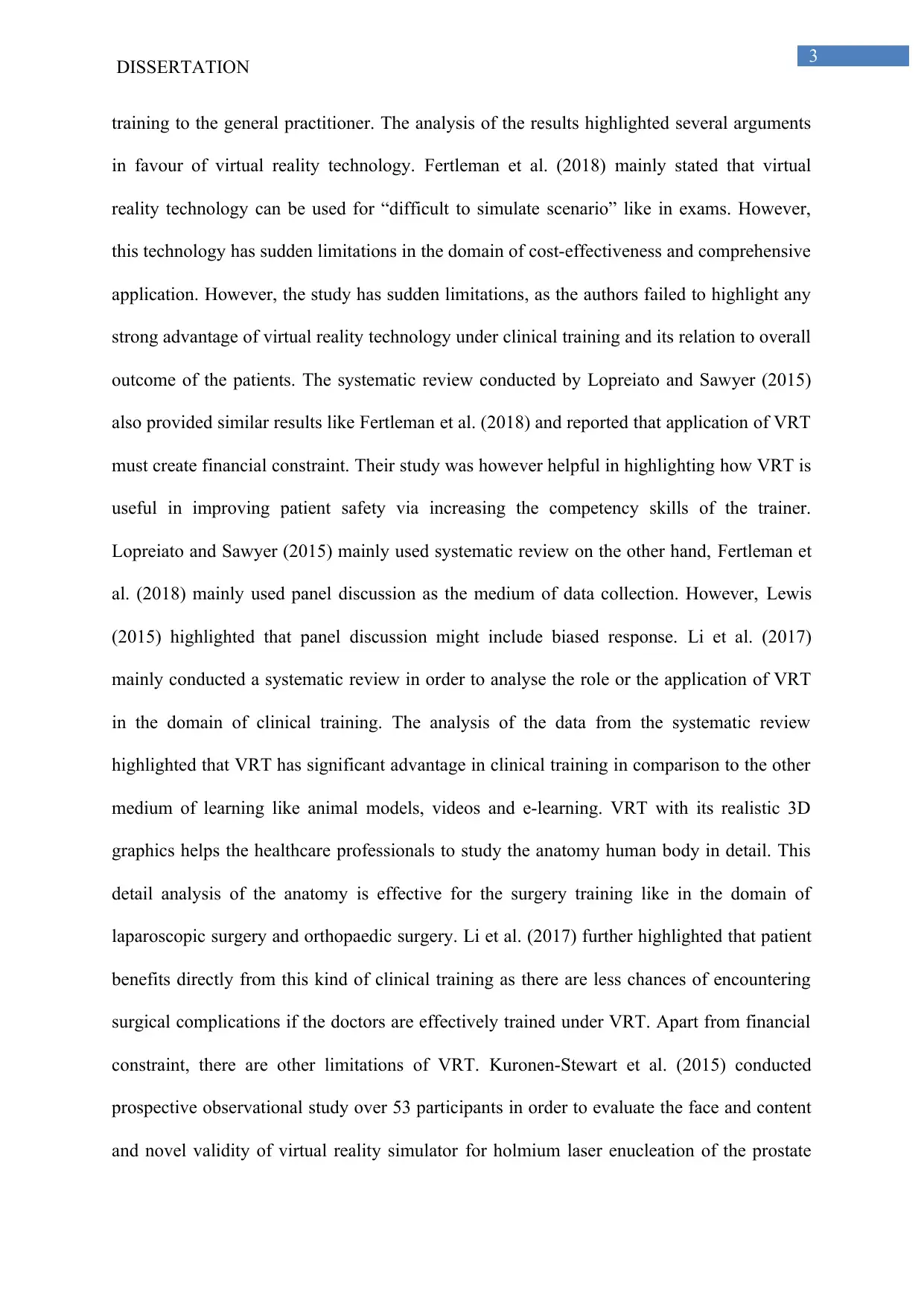
3
DISSERTATION
training to the general practitioner. The analysis of the results highlighted several arguments
in favour of virtual reality technology. Fertleman et al. (2018) mainly stated that virtual
reality technology can be used for “difficult to simulate scenario” like in exams. However,
this technology has sudden limitations in the domain of cost-effectiveness and comprehensive
application. However, the study has sudden limitations, as the authors failed to highlight any
strong advantage of virtual reality technology under clinical training and its relation to overall
outcome of the patients. The systematic review conducted by Lopreiato and Sawyer (2015)
also provided similar results like Fertleman et al. (2018) and reported that application of VRT
must create financial constraint. Their study was however helpful in highlighting how VRT is
useful in improving patient safety via increasing the competency skills of the trainer.
Lopreiato and Sawyer (2015) mainly used systematic review on the other hand, Fertleman et
al. (2018) mainly used panel discussion as the medium of data collection. However, Lewis
(2015) highlighted that panel discussion might include biased response. Li et al. (2017)
mainly conducted a systematic review in order to analyse the role or the application of VRT
in the domain of clinical training. The analysis of the data from the systematic review
highlighted that VRT has significant advantage in clinical training in comparison to the other
medium of learning like animal models, videos and e-learning. VRT with its realistic 3D
graphics helps the healthcare professionals to study the anatomy human body in detail. This
detail analysis of the anatomy is effective for the surgery training like in the domain of
laparoscopic surgery and orthopaedic surgery. Li et al. (2017) further highlighted that patient
benefits directly from this kind of clinical training as there are less chances of encountering
surgical complications if the doctors are effectively trained under VRT. Apart from financial
constraint, there are other limitations of VRT. Kuronen-Stewart et al. (2015) conducted
prospective observational study over 53 participants in order to evaluate the face and content
and novel validity of virtual reality simulator for holmium laser enucleation of the prostate
DISSERTATION
training to the general practitioner. The analysis of the results highlighted several arguments
in favour of virtual reality technology. Fertleman et al. (2018) mainly stated that virtual
reality technology can be used for “difficult to simulate scenario” like in exams. However,
this technology has sudden limitations in the domain of cost-effectiveness and comprehensive
application. However, the study has sudden limitations, as the authors failed to highlight any
strong advantage of virtual reality technology under clinical training and its relation to overall
outcome of the patients. The systematic review conducted by Lopreiato and Sawyer (2015)
also provided similar results like Fertleman et al. (2018) and reported that application of VRT
must create financial constraint. Their study was however helpful in highlighting how VRT is
useful in improving patient safety via increasing the competency skills of the trainer.
Lopreiato and Sawyer (2015) mainly used systematic review on the other hand, Fertleman et
al. (2018) mainly used panel discussion as the medium of data collection. However, Lewis
(2015) highlighted that panel discussion might include biased response. Li et al. (2017)
mainly conducted a systematic review in order to analyse the role or the application of VRT
in the domain of clinical training. The analysis of the data from the systematic review
highlighted that VRT has significant advantage in clinical training in comparison to the other
medium of learning like animal models, videos and e-learning. VRT with its realistic 3D
graphics helps the healthcare professionals to study the anatomy human body in detail. This
detail analysis of the anatomy is effective for the surgery training like in the domain of
laparoscopic surgery and orthopaedic surgery. Li et al. (2017) further highlighted that patient
benefits directly from this kind of clinical training as there are less chances of encountering
surgical complications if the doctors are effectively trained under VRT. Apart from financial
constraint, there are other limitations of VRT. Kuronen-Stewart et al. (2015) conducted
prospective observational study over 53 participants in order to evaluate the face and content
and novel validity of virtual reality simulator for holmium laser enucleation of the prostate
Paraphrase This Document
Need a fresh take? Get an instant paraphrase of this document with our AI Paraphraser
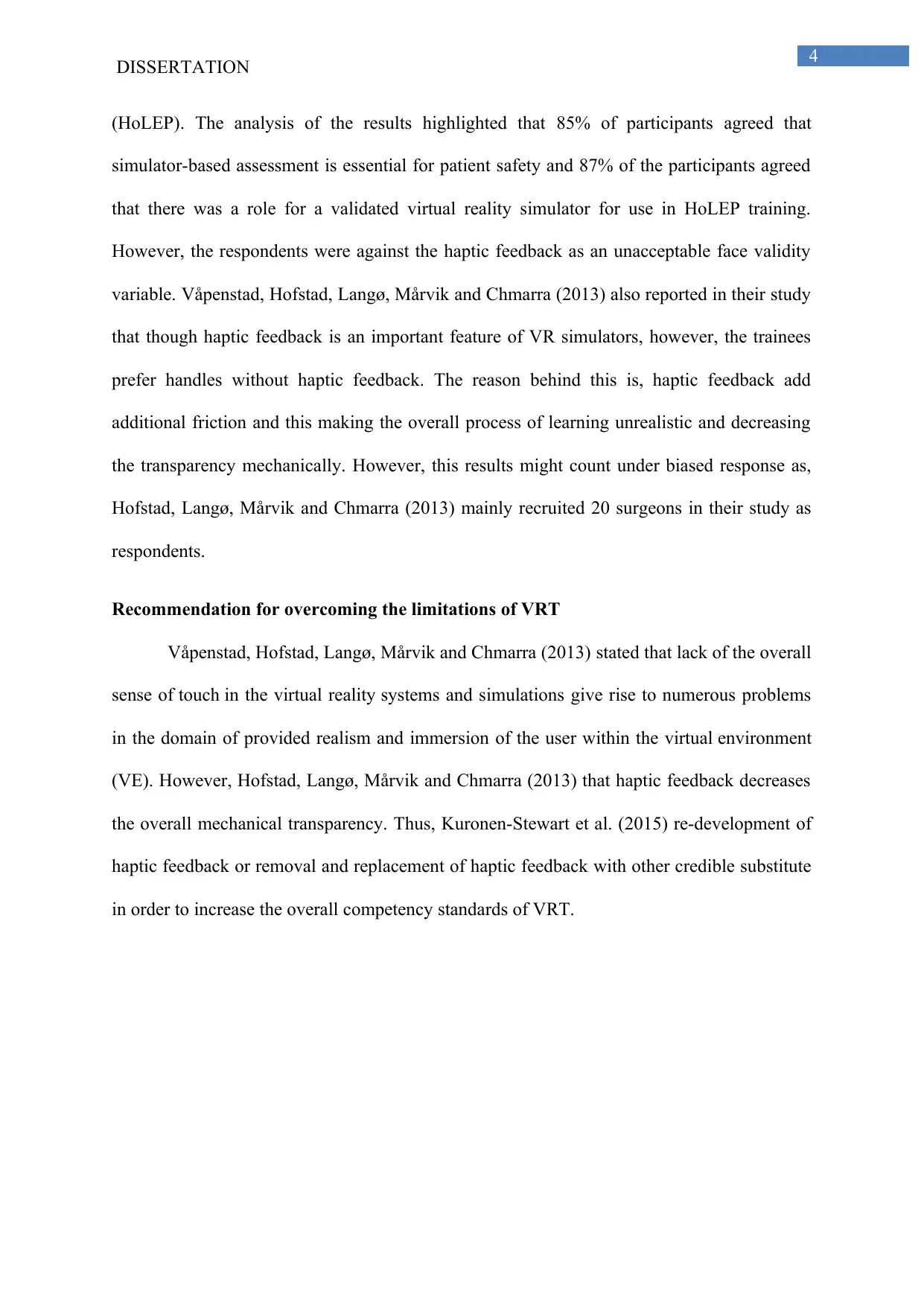
4
DISSERTATION
(HoLEP). The analysis of the results highlighted that 85% of participants agreed that
simulator-based assessment is essential for patient safety and 87% of the participants agreed
that there was a role for a validated virtual reality simulator for use in HoLEP training.
However, the respondents were against the haptic feedback as an unacceptable face validity
variable. Våpenstad, Hofstad, Langø, Mårvik and Chmarra (2013) also reported in their study
that though haptic feedback is an important feature of VR simulators, however, the trainees
prefer handles without haptic feedback. The reason behind this is, haptic feedback add
additional friction and this making the overall process of learning unrealistic and decreasing
the transparency mechanically. However, this results might count under biased response as,
Hofstad, Langø, Mårvik and Chmarra (2013) mainly recruited 20 surgeons in their study as
respondents.
Recommendation for overcoming the limitations of VRT
Våpenstad, Hofstad, Langø, Mårvik and Chmarra (2013) stated that lack of the overall
sense of touch in the virtual reality systems and simulations give rise to numerous problems
in the domain of provided realism and immersion of the user within the virtual environment
(VE). However, Hofstad, Langø, Mårvik and Chmarra (2013) that haptic feedback decreases
the overall mechanical transparency. Thus, Kuronen-Stewart et al. (2015) re-development of
haptic feedback or removal and replacement of haptic feedback with other credible substitute
in order to increase the overall competency standards of VRT.
DISSERTATION
(HoLEP). The analysis of the results highlighted that 85% of participants agreed that
simulator-based assessment is essential for patient safety and 87% of the participants agreed
that there was a role for a validated virtual reality simulator for use in HoLEP training.
However, the respondents were against the haptic feedback as an unacceptable face validity
variable. Våpenstad, Hofstad, Langø, Mårvik and Chmarra (2013) also reported in their study
that though haptic feedback is an important feature of VR simulators, however, the trainees
prefer handles without haptic feedback. The reason behind this is, haptic feedback add
additional friction and this making the overall process of learning unrealistic and decreasing
the transparency mechanically. However, this results might count under biased response as,
Hofstad, Langø, Mårvik and Chmarra (2013) mainly recruited 20 surgeons in their study as
respondents.
Recommendation for overcoming the limitations of VRT
Våpenstad, Hofstad, Langø, Mårvik and Chmarra (2013) stated that lack of the overall
sense of touch in the virtual reality systems and simulations give rise to numerous problems
in the domain of provided realism and immersion of the user within the virtual environment
(VE). However, Hofstad, Langø, Mårvik and Chmarra (2013) that haptic feedback decreases
the overall mechanical transparency. Thus, Kuronen-Stewart et al. (2015) re-development of
haptic feedback or removal and replacement of haptic feedback with other credible substitute
in order to increase the overall competency standards of VRT.
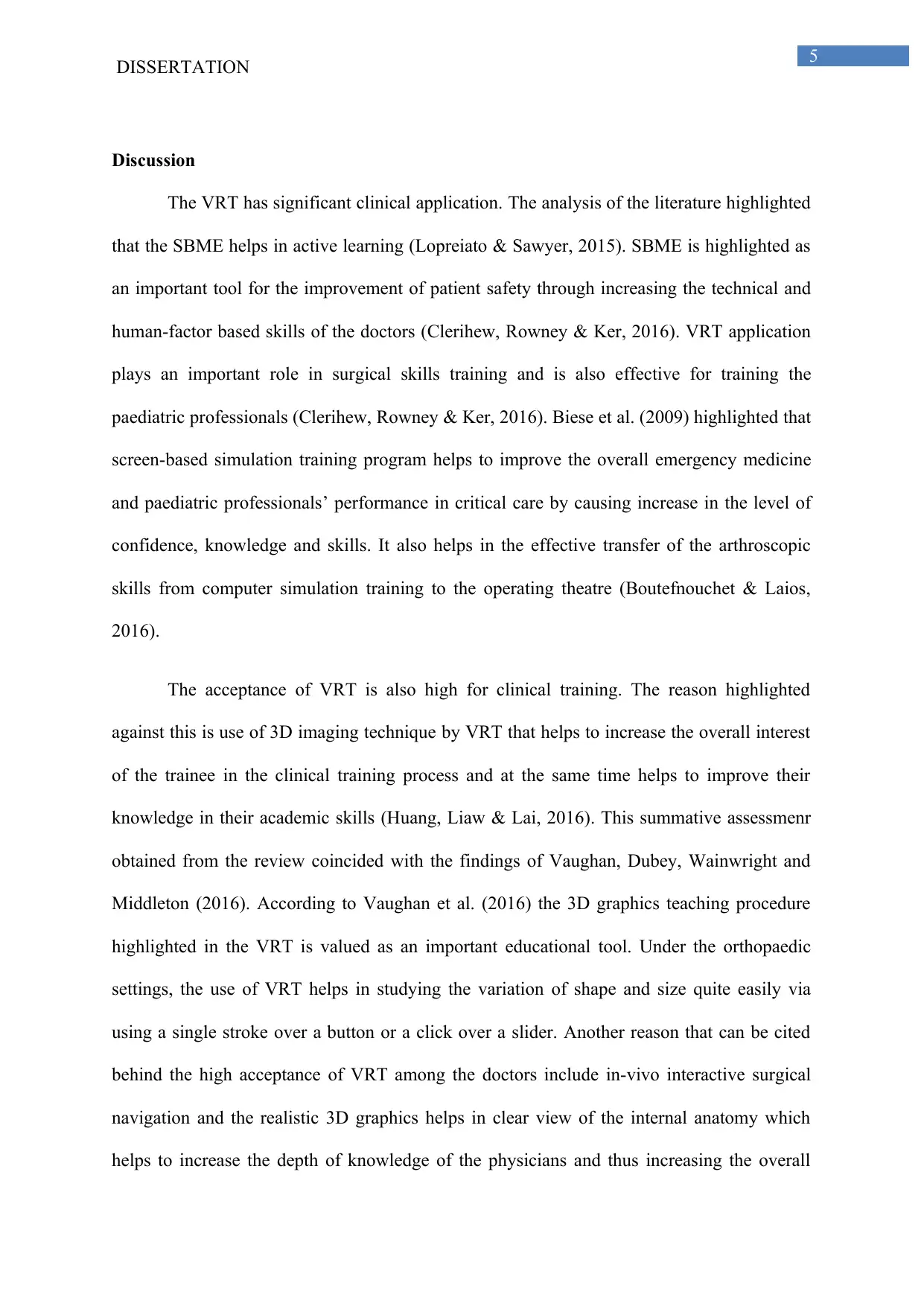
5
DISSERTATION
Discussion
The VRT has significant clinical application. The analysis of the literature highlighted
that the SBME helps in active learning (Lopreiato & Sawyer, 2015). SBME is highlighted as
an important tool for the improvement of patient safety through increasing the technical and
human-factor based skills of the doctors (Clerihew, Rowney & Ker, 2016). VRT application
plays an important role in surgical skills training and is also effective for training the
paediatric professionals (Clerihew, Rowney & Ker, 2016). Biese et al. (2009) highlighted that
screen-based simulation training program helps to improve the overall emergency medicine
and paediatric professionals’ performance in critical care by causing increase in the level of
confidence, knowledge and skills. It also helps in the effective transfer of the arthroscopic
skills from computer simulation training to the operating theatre (Boutefnouchet & Laios,
2016).
The acceptance of VRT is also high for clinical training. The reason highlighted
against this is use of 3D imaging technique by VRT that helps to increase the overall interest
of the trainee in the clinical training process and at the same time helps to improve their
knowledge in their academic skills (Huang, Liaw & Lai, 2016). This summative assessmenr
obtained from the review coincided with the findings of Vaughan, Dubey, Wainwright and
Middleton (2016). According to Vaughan et al. (2016) the 3D graphics teaching procedure
highlighted in the VRT is valued as an important educational tool. Under the orthopaedic
settings, the use of VRT helps in studying the variation of shape and size quite easily via
using a single stroke over a button or a click over a slider. Another reason that can be cited
behind the high acceptance of VRT among the doctors include in-vivo interactive surgical
navigation and the realistic 3D graphics helps in clear view of the internal anatomy which
helps to increase the depth of knowledge of the physicians and thus increasing the overall
DISSERTATION
Discussion
The VRT has significant clinical application. The analysis of the literature highlighted
that the SBME helps in active learning (Lopreiato & Sawyer, 2015). SBME is highlighted as
an important tool for the improvement of patient safety through increasing the technical and
human-factor based skills of the doctors (Clerihew, Rowney & Ker, 2016). VRT application
plays an important role in surgical skills training and is also effective for training the
paediatric professionals (Clerihew, Rowney & Ker, 2016). Biese et al. (2009) highlighted that
screen-based simulation training program helps to improve the overall emergency medicine
and paediatric professionals’ performance in critical care by causing increase in the level of
confidence, knowledge and skills. It also helps in the effective transfer of the arthroscopic
skills from computer simulation training to the operating theatre (Boutefnouchet & Laios,
2016).
The acceptance of VRT is also high for clinical training. The reason highlighted
against this is use of 3D imaging technique by VRT that helps to increase the overall interest
of the trainee in the clinical training process and at the same time helps to improve their
knowledge in their academic skills (Huang, Liaw & Lai, 2016). This summative assessmenr
obtained from the review coincided with the findings of Vaughan, Dubey, Wainwright and
Middleton (2016). According to Vaughan et al. (2016) the 3D graphics teaching procedure
highlighted in the VRT is valued as an important educational tool. Under the orthopaedic
settings, the use of VRT helps in studying the variation of shape and size quite easily via
using a single stroke over a button or a click over a slider. Another reason that can be cited
behind the high acceptance of VRT among the doctors include in-vivo interactive surgical
navigation and the realistic 3D graphics helps in clear view of the internal anatomy which
helps to increase the depth of knowledge of the physicians and thus increasing the overall
⊘ This is a preview!⊘
Do you want full access?
Subscribe today to unlock all pages.

Trusted by 1+ million students worldwide
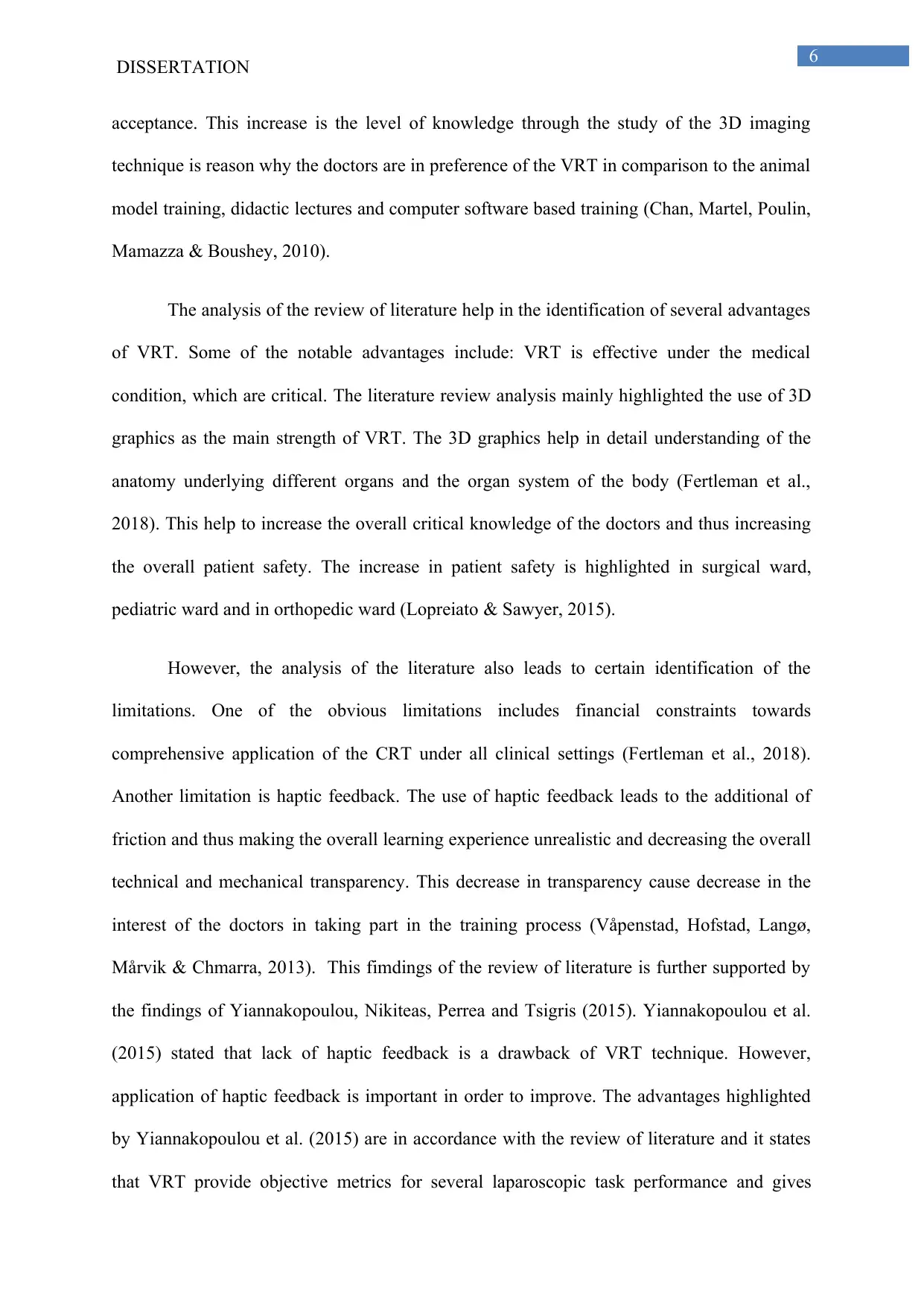
6
DISSERTATION
acceptance. This increase is the level of knowledge through the study of the 3D imaging
technique is reason why the doctors are in preference of the VRT in comparison to the animal
model training, didactic lectures and computer software based training (Chan, Martel, Poulin,
Mamazza & Boushey, 2010).
The analysis of the review of literature help in the identification of several advantages
of VRT. Some of the notable advantages include: VRT is effective under the medical
condition, which are critical. The literature review analysis mainly highlighted the use of 3D
graphics as the main strength of VRT. The 3D graphics help in detail understanding of the
anatomy underlying different organs and the organ system of the body (Fertleman et al.,
2018). This help to increase the overall critical knowledge of the doctors and thus increasing
the overall patient safety. The increase in patient safety is highlighted in surgical ward,
pediatric ward and in orthopedic ward (Lopreiato & Sawyer, 2015).
However, the analysis of the literature also leads to certain identification of the
limitations. One of the obvious limitations includes financial constraints towards
comprehensive application of the CRT under all clinical settings (Fertleman et al., 2018).
Another limitation is haptic feedback. The use of haptic feedback leads to the additional of
friction and thus making the overall learning experience unrealistic and decreasing the overall
technical and mechanical transparency. This decrease in transparency cause decrease in the
interest of the doctors in taking part in the training process (Våpenstad, Hofstad, Langø,
Mårvik & Chmarra, 2013). This fimdings of the review of literature is further supported by
the findings of Yiannakopoulou, Nikiteas, Perrea and Tsigris (2015). Yiannakopoulou et al.
(2015) stated that lack of haptic feedback is a drawback of VRT technique. However,
application of haptic feedback is important in order to improve. The advantages highlighted
by Yiannakopoulou et al. (2015) are in accordance with the review of literature and it states
that VRT provide objective metrics for several laparoscopic task performance and gives
DISSERTATION
acceptance. This increase is the level of knowledge through the study of the 3D imaging
technique is reason why the doctors are in preference of the VRT in comparison to the animal
model training, didactic lectures and computer software based training (Chan, Martel, Poulin,
Mamazza & Boushey, 2010).
The analysis of the review of literature help in the identification of several advantages
of VRT. Some of the notable advantages include: VRT is effective under the medical
condition, which are critical. The literature review analysis mainly highlighted the use of 3D
graphics as the main strength of VRT. The 3D graphics help in detail understanding of the
anatomy underlying different organs and the organ system of the body (Fertleman et al.,
2018). This help to increase the overall critical knowledge of the doctors and thus increasing
the overall patient safety. The increase in patient safety is highlighted in surgical ward,
pediatric ward and in orthopedic ward (Lopreiato & Sawyer, 2015).
However, the analysis of the literature also leads to certain identification of the
limitations. One of the obvious limitations includes financial constraints towards
comprehensive application of the CRT under all clinical settings (Fertleman et al., 2018).
Another limitation is haptic feedback. The use of haptic feedback leads to the additional of
friction and thus making the overall learning experience unrealistic and decreasing the overall
technical and mechanical transparency. This decrease in transparency cause decrease in the
interest of the doctors in taking part in the training process (Våpenstad, Hofstad, Langø,
Mårvik & Chmarra, 2013). This fimdings of the review of literature is further supported by
the findings of Yiannakopoulou, Nikiteas, Perrea and Tsigris (2015). Yiannakopoulou et al.
(2015) stated that lack of haptic feedback is a drawback of VRT technique. However,
application of haptic feedback is important in order to improve. The advantages highlighted
by Yiannakopoulou et al. (2015) are in accordance with the review of literature and it states
that VRT provide objective metrics for several laparoscopic task performance and gives
Paraphrase This Document
Need a fresh take? Get an instant paraphrase of this document with our AI Paraphraser
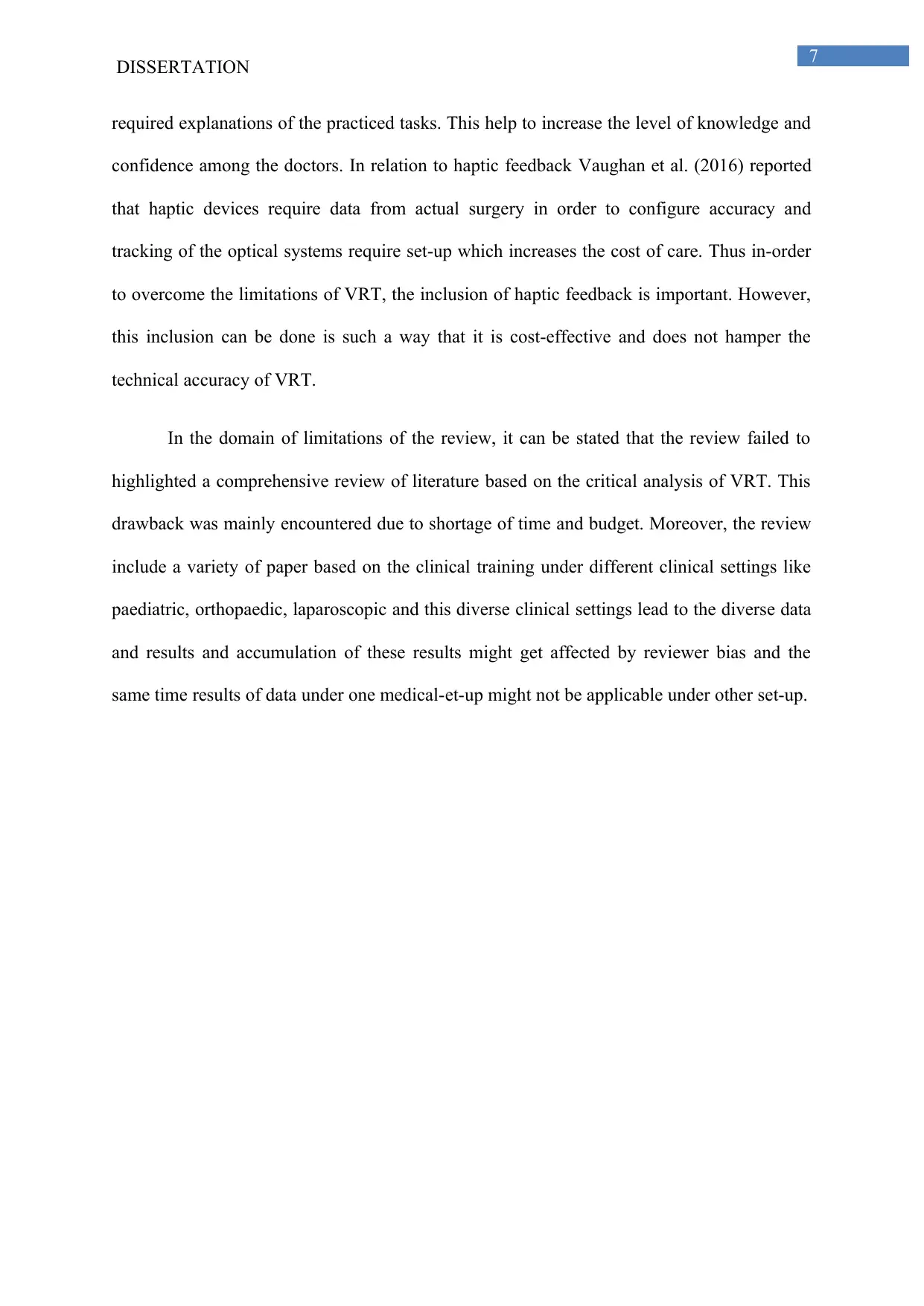
7
DISSERTATION
required explanations of the practiced tasks. This help to increase the level of knowledge and
confidence among the doctors. In relation to haptic feedback Vaughan et al. (2016) reported
that haptic devices require data from actual surgery in order to configure accuracy and
tracking of the optical systems require set-up which increases the cost of care. Thus in-order
to overcome the limitations of VRT, the inclusion of haptic feedback is important. However,
this inclusion can be done is such a way that it is cost-effective and does not hamper the
technical accuracy of VRT.
In the domain of limitations of the review, it can be stated that the review failed to
highlighted a comprehensive review of literature based on the critical analysis of VRT. This
drawback was mainly encountered due to shortage of time and budget. Moreover, the review
include a variety of paper based on the clinical training under different clinical settings like
paediatric, orthopaedic, laparoscopic and this diverse clinical settings lead to the diverse data
and results and accumulation of these results might get affected by reviewer bias and the
same time results of data under one medical-et-up might not be applicable under other set-up.
DISSERTATION
required explanations of the practiced tasks. This help to increase the level of knowledge and
confidence among the doctors. In relation to haptic feedback Vaughan et al. (2016) reported
that haptic devices require data from actual surgery in order to configure accuracy and
tracking of the optical systems require set-up which increases the cost of care. Thus in-order
to overcome the limitations of VRT, the inclusion of haptic feedback is important. However,
this inclusion can be done is such a way that it is cost-effective and does not hamper the
technical accuracy of VRT.
In the domain of limitations of the review, it can be stated that the review failed to
highlighted a comprehensive review of literature based on the critical analysis of VRT. This
drawback was mainly encountered due to shortage of time and budget. Moreover, the review
include a variety of paper based on the clinical training under different clinical settings like
paediatric, orthopaedic, laparoscopic and this diverse clinical settings lead to the diverse data
and results and accumulation of these results might get affected by reviewer bias and the
same time results of data under one medical-et-up might not be applicable under other set-up.
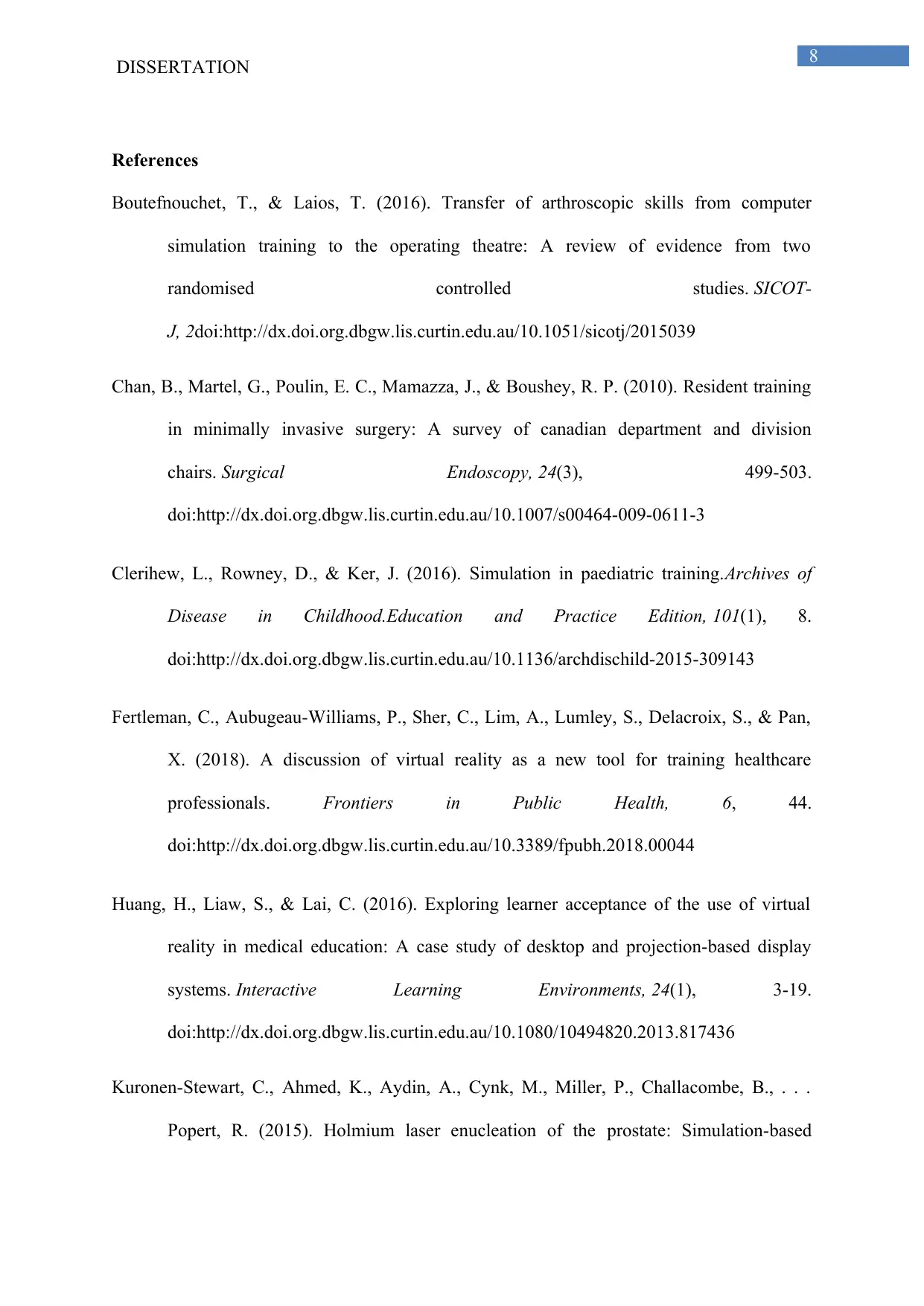
8
DISSERTATION
References
Boutefnouchet, T., & Laios, T. (2016). Transfer of arthroscopic skills from computer
simulation training to the operating theatre: A review of evidence from two
randomised controlled studies. SICOT-
J, 2doi:http://dx.doi.org.dbgw.lis.curtin.edu.au/10.1051/sicotj/2015039
Chan, B., Martel, G., Poulin, E. C., Mamazza, J., & Boushey, R. P. (2010). Resident training
in minimally invasive surgery: A survey of canadian department and division
chairs. Surgical Endoscopy, 24(3), 499-503.
doi:http://dx.doi.org.dbgw.lis.curtin.edu.au/10.1007/s00464-009-0611-3
Clerihew, L., Rowney, D., & Ker, J. (2016). Simulation in paediatric training.Archives of
Disease in Childhood.Education and Practice Edition, 101(1), 8.
doi:http://dx.doi.org.dbgw.lis.curtin.edu.au/10.1136/archdischild-2015-309143
Fertleman, C., Aubugeau-Williams, P., Sher, C., Lim, A., Lumley, S., Delacroix, S., & Pan,
X. (2018). A discussion of virtual reality as a new tool for training healthcare
professionals. Frontiers in Public Health, 6, 44.
doi:http://dx.doi.org.dbgw.lis.curtin.edu.au/10.3389/fpubh.2018.00044
Huang, H., Liaw, S., & Lai, C. (2016). Exploring learner acceptance of the use of virtual
reality in medical education: A case study of desktop and projection-based display
systems. Interactive Learning Environments, 24(1), 3-19.
doi:http://dx.doi.org.dbgw.lis.curtin.edu.au/10.1080/10494820.2013.817436
Kuronen-Stewart, C., Ahmed, K., Aydin, A., Cynk, M., Miller, P., Challacombe, B., . . .
Popert, R. (2015). Holmium laser enucleation of the prostate: Simulation-based
DISSERTATION
References
Boutefnouchet, T., & Laios, T. (2016). Transfer of arthroscopic skills from computer
simulation training to the operating theatre: A review of evidence from two
randomised controlled studies. SICOT-
J, 2doi:http://dx.doi.org.dbgw.lis.curtin.edu.au/10.1051/sicotj/2015039
Chan, B., Martel, G., Poulin, E. C., Mamazza, J., & Boushey, R. P. (2010). Resident training
in minimally invasive surgery: A survey of canadian department and division
chairs. Surgical Endoscopy, 24(3), 499-503.
doi:http://dx.doi.org.dbgw.lis.curtin.edu.au/10.1007/s00464-009-0611-3
Clerihew, L., Rowney, D., & Ker, J. (2016). Simulation in paediatric training.Archives of
Disease in Childhood.Education and Practice Edition, 101(1), 8.
doi:http://dx.doi.org.dbgw.lis.curtin.edu.au/10.1136/archdischild-2015-309143
Fertleman, C., Aubugeau-Williams, P., Sher, C., Lim, A., Lumley, S., Delacroix, S., & Pan,
X. (2018). A discussion of virtual reality as a new tool for training healthcare
professionals. Frontiers in Public Health, 6, 44.
doi:http://dx.doi.org.dbgw.lis.curtin.edu.au/10.3389/fpubh.2018.00044
Huang, H., Liaw, S., & Lai, C. (2016). Exploring learner acceptance of the use of virtual
reality in medical education: A case study of desktop and projection-based display
systems. Interactive Learning Environments, 24(1), 3-19.
doi:http://dx.doi.org.dbgw.lis.curtin.edu.au/10.1080/10494820.2013.817436
Kuronen-Stewart, C., Ahmed, K., Aydin, A., Cynk, M., Miller, P., Challacombe, B., . . .
Popert, R. (2015). Holmium laser enucleation of the prostate: Simulation-based
⊘ This is a preview!⊘
Do you want full access?
Subscribe today to unlock all pages.

Trusted by 1+ million students worldwide
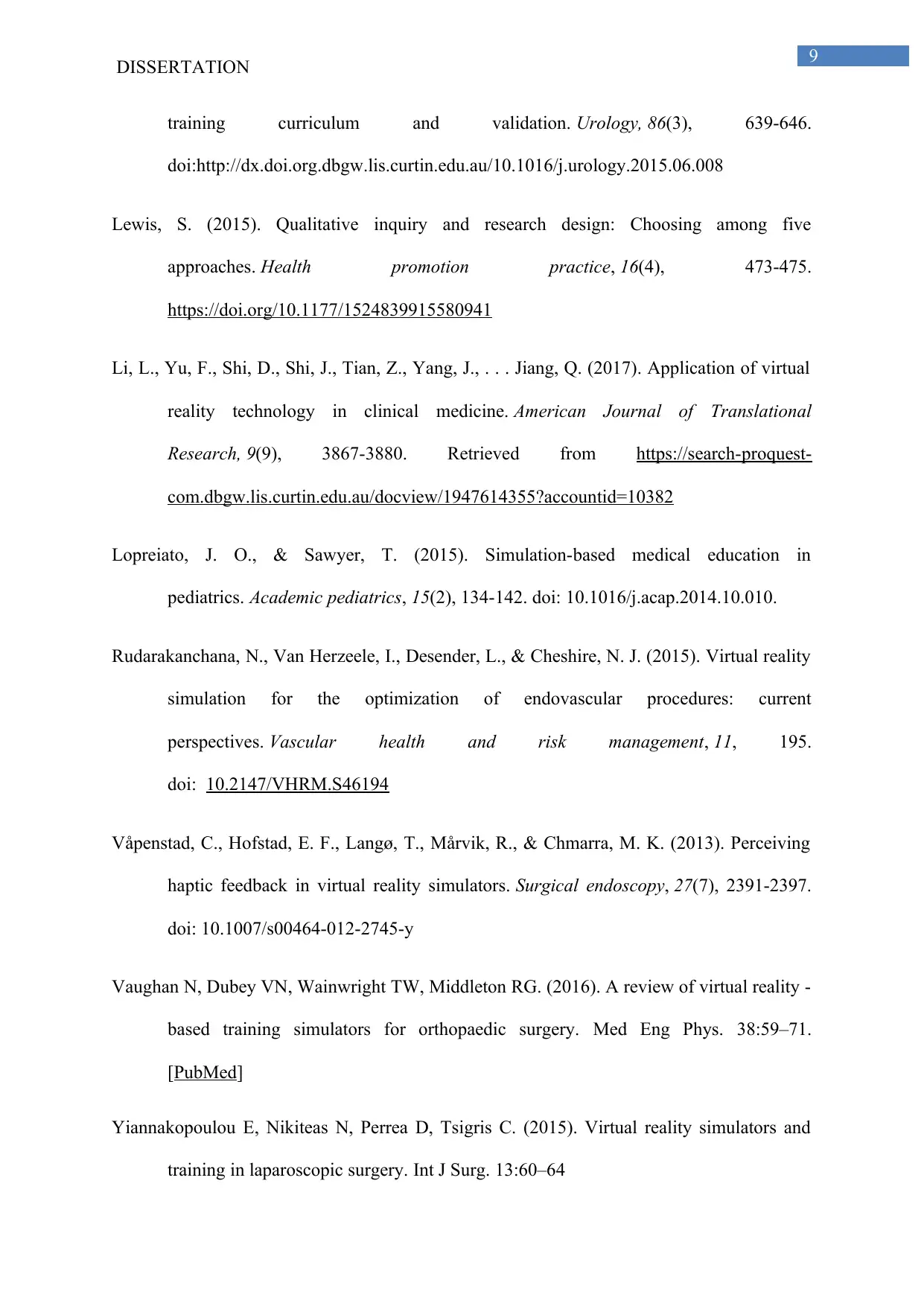
9
DISSERTATION
training curriculum and validation. Urology, 86(3), 639-646.
doi:http://dx.doi.org.dbgw.lis.curtin.edu.au/10.1016/j.urology.2015.06.008
Lewis, S. (2015). Qualitative inquiry and research design: Choosing among five
approaches. Health promotion practice, 16(4), 473-475.
https://doi.org/10.1177/1524839915580941
Li, L., Yu, F., Shi, D., Shi, J., Tian, Z., Yang, J., . . . Jiang, Q. (2017). Application of virtual
reality technology in clinical medicine. American Journal of Translational
Research, 9(9), 3867-3880. Retrieved from https://search-proquest-
com.dbgw.lis.curtin.edu.au/docview/1947614355?accountid=10382
Lopreiato, J. O., & Sawyer, T. (2015). Simulation-based medical education in
pediatrics. Academic pediatrics, 15(2), 134-142. doi: 10.1016/j.acap.2014.10.010.
Rudarakanchana, N., Van Herzeele, I., Desender, L., & Cheshire, N. J. (2015). Virtual reality
simulation for the optimization of endovascular procedures: current
perspectives. Vascular health and risk management, 11, 195.
doi: 10.2147/VHRM.S46194
Våpenstad, C., Hofstad, E. F., Langø, T., Mårvik, R., & Chmarra, M. K. (2013). Perceiving
haptic feedback in virtual reality simulators. Surgical endoscopy, 27(7), 2391-2397.
doi: 10.1007/s00464-012-2745-y
Vaughan N, Dubey VN, Wainwright TW, Middleton RG. (2016). A review of virtual reality -
based training simulators for orthopaedic surgery. Med Eng Phys. 38:59–71.
[PubMed]
Yiannakopoulou E, Nikiteas N, Perrea D, Tsigris C. (2015). Virtual reality simulators and
training in laparoscopic surgery. Int J Surg. 13:60–64
DISSERTATION
training curriculum and validation. Urology, 86(3), 639-646.
doi:http://dx.doi.org.dbgw.lis.curtin.edu.au/10.1016/j.urology.2015.06.008
Lewis, S. (2015). Qualitative inquiry and research design: Choosing among five
approaches. Health promotion practice, 16(4), 473-475.
https://doi.org/10.1177/1524839915580941
Li, L., Yu, F., Shi, D., Shi, J., Tian, Z., Yang, J., . . . Jiang, Q. (2017). Application of virtual
reality technology in clinical medicine. American Journal of Translational
Research, 9(9), 3867-3880. Retrieved from https://search-proquest-
com.dbgw.lis.curtin.edu.au/docview/1947614355?accountid=10382
Lopreiato, J. O., & Sawyer, T. (2015). Simulation-based medical education in
pediatrics. Academic pediatrics, 15(2), 134-142. doi: 10.1016/j.acap.2014.10.010.
Rudarakanchana, N., Van Herzeele, I., Desender, L., & Cheshire, N. J. (2015). Virtual reality
simulation for the optimization of endovascular procedures: current
perspectives. Vascular health and risk management, 11, 195.
doi: 10.2147/VHRM.S46194
Våpenstad, C., Hofstad, E. F., Langø, T., Mårvik, R., & Chmarra, M. K. (2013). Perceiving
haptic feedback in virtual reality simulators. Surgical endoscopy, 27(7), 2391-2397.
doi: 10.1007/s00464-012-2745-y
Vaughan N, Dubey VN, Wainwright TW, Middleton RG. (2016). A review of virtual reality -
based training simulators for orthopaedic surgery. Med Eng Phys. 38:59–71.
[PubMed]
Yiannakopoulou E, Nikiteas N, Perrea D, Tsigris C. (2015). Virtual reality simulators and
training in laparoscopic surgery. Int J Surg. 13:60–64
1 out of 10
Your All-in-One AI-Powered Toolkit for Academic Success.
+13062052269
info@desklib.com
Available 24*7 on WhatsApp / Email
![[object Object]](/_next/static/media/star-bottom.7253800d.svg)
Unlock your academic potential
Copyright © 2020–2025 A2Z Services. All Rights Reserved. Developed and managed by ZUCOL.
